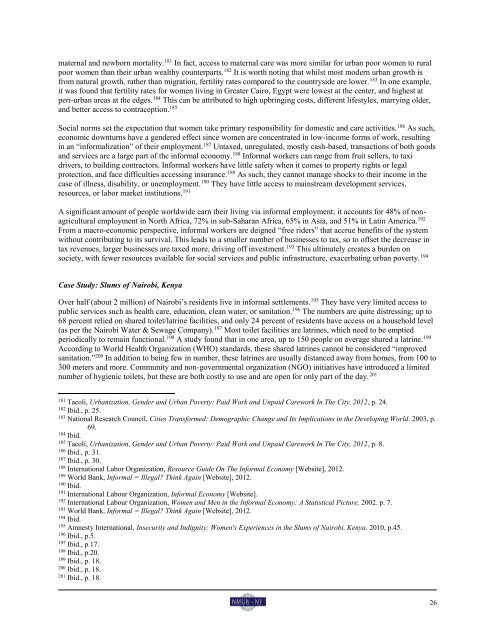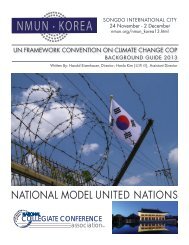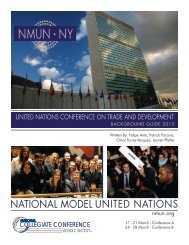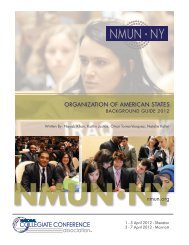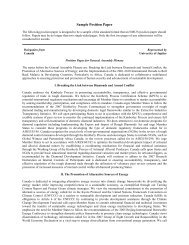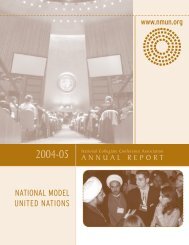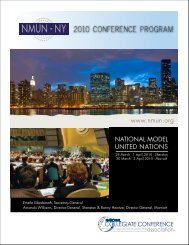UNFPA Background Guide - National Model United Nations
UNFPA Background Guide - National Model United Nations
UNFPA Background Guide - National Model United Nations
You also want an ePaper? Increase the reach of your titles
YUMPU automatically turns print PDFs into web optimized ePapers that Google loves.
maternal and newborn mortality. 181 In fact, access to maternal care was more similar for urban poor women to rural<br />
poor women than their urban wealthy counterparts. 182 It is worth noting that whilst most modern urban growth is<br />
from natural growth, rather than migration, fertility rates compared to the countryside are lower. 183 In one example,<br />
it was found that fertility rates for women living in Greater Cairo, Egypt were lowest at the center, and highest at<br />
peri-urban areas at the edges. 184 This can be attributed to high upbringing costs, different lifestyles, marrying older,<br />
and better access to contraception. 185<br />
Social norms set the expectation that women take primary responsibility for domestic and care activities. 186 As such,<br />
economic downturns have a gendered effect since women are concentrated in low-income forms of work, resulting<br />
in an “informalization” of their employment. 187 Untaxed, unregulated, mostly cash-based, transactions of both goods<br />
and services are a large part of the informal economy. 188 Informal workers can range from fruit sellers, to taxi<br />
drivers, to building contractors. Informal workers have little safety when it comes to property rights or legal<br />
protection, and face difficulties accessing insurance. 189 As such, they cannot manage shocks to their income in the<br />
case of illness, disability, or unemployment. 190 They have little access to mainstream development services,<br />
resources, or labor market institutions. 191<br />
A significant amount of people worldwide earn their living via informal employment; it accounts for 48% of nonagricultural<br />
employment in North Africa, 72% in sub-Saharan Africa, 65% in Asia, and 51% in Latin America. 192<br />
From a macro-economic perspective, informal workers are deigned “free riders” that accrue benefits of the system<br />
without contributing to its survival. This leads to a smaller number of businesses to tax, so to offset the decrease in<br />
tax revenues, larger businesses are taxed more, driving off investment. 193 This ultimately creates a burden on<br />
society, with fewer resources available for social services and public infrastructure, exacerbating urban poverty. 194<br />
Case Study: Slums of Nairobi, Kenya<br />
Over half (about 2 million) of Nairobi’s residents live in informal settlements. 195 They have very limited access to<br />
public services such as health care, education, clean water, or sanitation. 196 The numbers are quite distressing; up to<br />
68 percent relied on shared toilet/latrine facilities, and only 24 percent of residents have access on a household level<br />
(as per the Nairobi Water & Sewage Company). 197 Most toilet facilities are latrines, which need to be emptied<br />
periodically to remain functional. 198 A study found that in one area, up to 150 people on average shared a latrine. 199<br />
According to World Health Organization (WHO) standards, these shared latrines cannot be considered “improved<br />
sanitation.” 200 In addition to being few in number, these latrines are usually distanced away from homes, from 100 to<br />
300 meters and more. Community and non-governmental organization (NGO) initiatives have introduced a limited<br />
number of hygienic toilets, but these are both costly to use and are open for only part of the day. 201<br />
181<br />
Tacoli, Urbanization, Gender and Urban Poverty: Paid Work and Unpaid Carework In The City, 2012, p. 24.<br />
182<br />
Ibid., p. 25.<br />
183<br />
<strong>National</strong> Research Council, Cities Transformed: Demographic Change and Its Implications in the Developing World. 2003, p.<br />
69.<br />
184<br />
Ibid.<br />
185<br />
Tacoli, Urbanization, Gender and Urban Poverty: Paid Work and Unpaid Carework In The City, 2012, p. 8.<br />
186<br />
Ibid., p. 31.<br />
187<br />
Ibid., p. 30.<br />
188<br />
International Labor Organization, Resource <strong>Guide</strong> On The Informal Economy [Website], 2012.<br />
189<br />
World Bank, Informal = Illegal? Think Again [Website], 2012.<br />
190<br />
Ibid.<br />
191<br />
International Labour Organization, Informal Economy [Website].<br />
192<br />
International Labour Organization, Women and Men in the Informal Economy: A Statistical Picture, 2002. p. 7.<br />
193<br />
World Bank, Informal = Illegal? Think Again [Website], 2012.<br />
194<br />
Ibid.<br />
195<br />
Amnesty International, Insecurity and Indignity: Women's Experiences in the Slums of Nairobi, Kenya, 2010, p.45.<br />
196<br />
Ibid., p.5.<br />
197<br />
Ibid., p.17.<br />
198<br />
Ibid., p.20.<br />
199<br />
Ibid., p. 18.<br />
200<br />
Ibid., p. 18.<br />
201<br />
Ibid., p. 18.<br />
26


